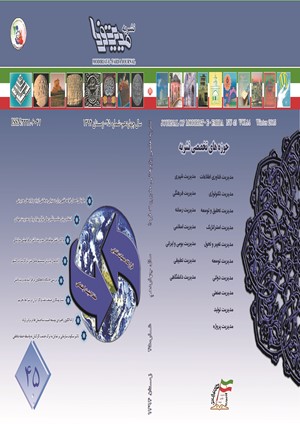Subject Areas :
1 -
2 -
Keywords:
Abstract :
1. Agarwal, A.;Shankar, R. & Tiwari, M. K. (2007). Modeling agility of supply chain. Industrial Marketing Management, 36(4), 443-457.
2. Avelar-Sosa, L.;García-Alcaraz, J. L. & Castrellón-Torres, J. P. (2014). The Effects of Some Risk Factors in the Supply Chains Performance: A Case of Study. Journal of Applied Research and Technology, 12(5), 958-968.
3. Azar, A.;Tizro, A.;Moghbel Baaraz, A. & Anvari Rostami, A. (2011). the design of supply chain agility model: Interpretive- structural modeling approach. Human Sciences MODARES, 14(4), 1-25.
4. Baker, P. (2008). The design and operation of distribution centres within agile supply chains. International Journal of Production Economics, 111(1), 27-41.
5. Bal, J.;Wilding, R. & Gundry, J. (1999). Virtual Teaming in the Agile Supply Chain. The International Journal of Logistics Management, 10(2), 71-82.
6. Braunscheidel, M. J. & State University of New York at Buffalo. (2005). Antecedents of supply chain agility: An empirical investigation.
7. Christopher, M. (2000). The agile supply chain: competing in volatile markets. Industrial marketing management, 29(1), 37-44.
8. Christopher, M. & Denis, T. (2001). An integrated model for the design of agile supply chains. International Journal of Physical Distribution & Logistics Management, 31(4), 235-246.
9. Garver, M. S. & Mentzer, J. T. (1999). Logistics research methods: employing structural equation modeling to test for construct validity. Journal of business logistics, 20(1), 33.
10. Giachetti, R. E.;Martinez, L. D.;Sáenz, O. A. & Chen, C.-S. (2003). Analysis of the structural measures of flexibility and agility using a measurement theoretical framework. International Journal of Production Economics, 86(1), 47-62.
11. Gligor, D. M.;Esmark, C. L. & Holcomb, M. C. (2014). Performance outcomes of supply chain agility: When should you be agile? Journal of Operations Management.
12. Goldman, S. L. (1995). Agile competitors and virtual organizations: strategies for enriching the customer: Van Nostrand Reinhold Company.
13. Gunasekaran, A.;Patel, C. & Tirtiroglu, E. (2001). Performance measures and metrics in a supply chain environment. International Journal of Operations & Production Management, 21(1/2), 71-87. doi: doi:10.1108/01443570110358468
14. Hoe, S. L. (2008). Issues and procedures in adopting structural equation modeling technique. Journal of applied quantitative methods, 3(1), 76-83.
15. Hoek, R. I. v.;Harrison, A. & Christopher, M. (2001). Measuring agile capabilities in the supply chain. International Journal of Operations & Production Management, 21(1/2), 126-148.
16. Hoelter, J. W. (1983). The analysis of covariance structures goodness-of-fit indices. Sociological Methods & Research, 11(3), 325-344.
17. Holweg, M. (2005). The three dimensions of responsiveness. International Journal of Operations & Production Management, 25(7), 603-622.
18. Ismail, H. S. & Sharifi, H. (2006). A balanced approach to building agile supply chainsnull. International Journal of Physical Distribution & Logistics Management, 36(6), 431-444.
19. Jackson, D. L. (2003). Revisiting sample size and number of parameter estimates: Some support for the N: q hypothesis. Structural Equation Modeling, 10(1), 128-141.
20. Jaefarnejad, A. & Shahaei, B. (2007). Introduction to organizational agility and agile manufacturing. Tehran: Mehrabane-Nashr Institute.
21. Khodadad Hosseini, S. H.;Osanlou, B.;Moshabaki, A. & Kordnaiej, A. (2013). Designing Customer Profitability Model forOrganizations: Case Study of Electronic Industry in Iran. Management Researches in Iran, 17(1), 73-94.
22. Kline, R. B. (2011). Principles and practice of structural equation modeling (3rd ed.). New York: Guilford Press.
23. Li, D. & Christopher, O. B. (1999). Integrated decision modelling of supply chain efficiency. International Journal of Production Economics, 59(1–3), 147-157.
24. Lin, C.-T.;Chiu, H. & Chu, P.-Y. (2006). Agility index in the supply chain. International Journal of Production Economics, 100(2), 285-299.
25. Lou, P.;Zhou, Z.-d.;Chen, Y.-P. & Ai, W. (2004). Study on multi-agent-based agile supply chain management. The International Journal of Advanced Manufacturing Technology, 23(3-4), 197-203.
26. Mason‐Jones, R.;Naylor, B. & Towill, D. R. (2000). Engineering the leagile supply chain. International Journal of Agile Management Systems, 2(1), 54-61.
27. McQuitty, S. (2004). Statistical power and structural equation models in business research. Journal of Business Research, 57(2), 175-183.
28. Nagel, R. N. & Dove, R. (1991). 21st century manufacturing enterprise strategy: An industry-led view: DIANE Publishing.
29. Sangari, M. S.;Razmi, J. & Zolfaghari, S. (2015). Developing a practical evaluation framework for identifying critical factors to achieve supply chain agility. Measurement, 62, 205-214.
30.Shah, R. & Goldstein, S. M. (2006). Use of structural equation modeling in operations management research: Looking back and forward. Journal of Operations Management, 24(2), 148-169.
31. Sinha, A. K.;Swati, P. & Anand, A. (2015). Responsive supply chain: modeling and simulation. Management Science Letters, 5(6), 639-650.
32. Sivo, S. A.;Fan, X.;Witta, E. L. & Willse, J. T. (2006). The Search for "Optimal" Cutoff Properties: Fit Index Criteria in Structural Equation Modeling. The Journal of Experimental Education, 74(3), 267-288.
33. Stratton, R. & Warburton, R. D. H. (2003). The strategic integration of agile and lean supply. International Journal of Production Economics, 85(2), 183-198.
34. Svensson, G. (2001). Perceived trust towards suppliers and customers in supply chains of the Swedish automotive industry. International Journal of Physical Distribution & Logistics Management, 31(9), 647-662.
35. Swafford, P. M.;Ghosh, S. & Murthy, N. (2006). The antecedents of supply chain agility of a firm: Scale development and model testing. Journal of Operations Management, 24(2), 170-188.
36. Swafford, P. M.;Ghosh, S. & Murthy, N. (2008). Achieving supply chain agility through IT integration and flexibility. International Journal of Production Economics, 116(2), 288-297.
37. Teece, D. J.;Pisano, G. & Shuen, A. (1997). Dynamic capabilities and strategic management. Strategic Management Journal, 18(7), 509-533.
38. Tolone, W. J. (2000). Virtual situation rooms: connecting people across enterprises for supply-chain agility. Computer-Aided Design, 32(2), 109-117.
39. Yang, J. (2014). Supply chain agility: Securing performance for Chinese manufacturers. International Journal of Production Economics, 150, 104-113.
40. Yuh-Chuan, S. & Ching-Torng, L. (2002). Agility index of manufacturing firm-a fuzzy-logic-based approach. Paper presented at the Engineering Management Conference, 2002. IEMC '02. 2002 IEEE International.
41. Yusuf, Y. Y.;Sarhadi, M. & Gunasekaran, A. (1999). Agile manufacturing:: The drivers, concepts and attributes. International Journal of Production Economics, 62(1–2), 33-43.


